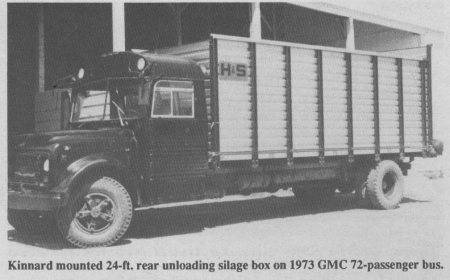
Rod Kinnard has been turning school buses into self-unloading wagons for over 25 years. His latest self-propelled wagon was built from a 1973 GMC 72-passenger bus equipped with a 5-speed transmission. He mounted a 24-ft. rear unloading H & S silage box on it.
He drives the rig over 15 miles between farms, traveling at speeds up to 45 mph. "We use it mostly to haul corn silage and haylage from the field to our bunker silo," says Kinnard, a dairyman who made the conversion last spring. "It's much faster than pulling a wagon behind a tractor and is much safer because you can see traffic behind you on the road. The wagon holds about 10 tons of silage. We put up 5,000 to 6,000 tons per year. It's much less expensive than buying a truck. I expect it to last 10 to 15 years.
"We pull a high-lift dump box behind our chopper and dump the load over the side of the school bus wagon. The rear-unloading apron is powered by a hydraulic motor that's driven by a 37 gpm hydraulic pump. The pump runs off a pto shaft that I mounted on the bus transmission. I also mounted a valve and hydraulic oil reservoir beside the seat. To unload the wagon, I depress the clutch, put the pto in gear, and open the valve. As the apron moves backward, silage pushes the door open at the back. It takes only 1 to 1 1/2 minutes to unload compared to about 7 minutes for side-unload models.
"It works good, but I wish it had a 2-speed rear end instead of a 5-speed transmission for going up hills and through muddy fields."
Kinnard stripped the bus down to the frame, leaving the cab, engine, and axles. He cut off the body of the bus behind the driver's seat and made an enclosed cab by cutting off a 2-ft. section at the back of the bus and welding it to the front part of the body. He then bolted the wagon box onto the rear frame.
